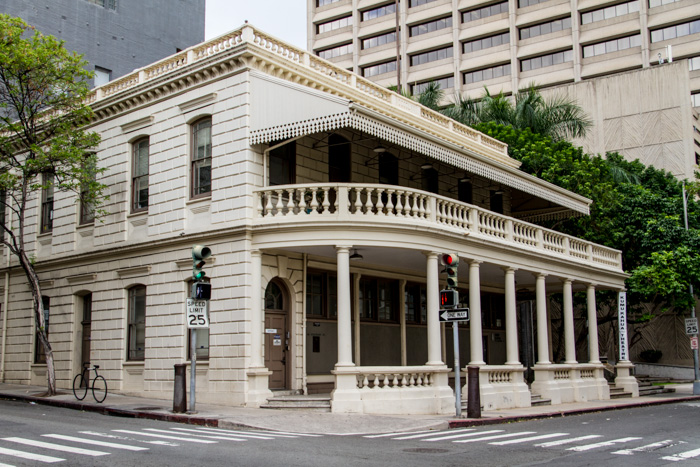
Photo by John Loggins
At the time of its construction in 1870, the two-story Kamehameha V Post Office Building located at 46 Merchant Street in downtown Honolulu, was recognized as one of the outstanding public buildings in the Hawaiian Kingdom. Designed in Neoclassical style by J.G. Osborne who hailed from Yorkshire, England and was noted for his brickmaking, it is particularly significant in the history of building construction. It is the first building in Hawai‘i, and the oldest in America, to have made early use of concrete utilizing large blocks, laid as ashlar (masonry made of large square-cut stones) for exterior bearing walls, paired with the use of iron bars for reinforcement of formed structural concrete.
When construction was completed in 1871, the Postmaster General and The Hawaiian Gazette, the government newspaper, moved into the building followed over the years by other small companies that needed office space. In 1894, the post office took over the building as the sole tenant. The Kamehameha V Post Office Building served as Honolulu’s main post office until it moved to the Federal Building in 1922. Shortly after, the building was renovated and used as a postal sub-station, as well as space for the Territorial Tax Office. In 1946, the district courts took up residence in the building, and a portion of the portico on Merchant Street was enclosed for more office space.

In 1993, the Kamehameha V Post Office Building was fully restored and renovated for theater usage and it has been home to the Kumu Kahua Theatre ever since. Founded in 1971 by a group of graduate students at the University of Hawai‘i, with the original goal of producing locally-written experimental creations, Kumu Kahua has helped develop more than 250 original works that has influenced hundreds of actors, playwrights, directors, technicians, and community members. The Hawaiian language words kumu and kahua translate to “original stage.” The theatre’s mission is broad, encompassing both staging locally written plays either set in Hawai‘i or dealing with aspects of the Hawaiian experience, to providing a theatrical platform and training for local theatre creatives. At the time of its inception, there was no local theatre devoted to telling stories of these islands and its various cultures.
 Kumu Kahua met 2020’s COVID multiple challenges of health and societal disruption with resourcefulness, resilience, sensitivity and creativity pivoting existing programs, partnering and creating new content. Pivots included continuing Backstage with Donna Blanchard, one-on-one dialogues with artists (a reboot of the popular interview series featured on ThinkTech and Olelo). Original performances that address racism and injustice in America were livestreamed, emerging from collaborative efforts as part of the Reset Theatre Coalition. The Masked Artist was a call out for artists and other volunteers of the theatre to create art in any medium, inspired by the COVID stay-at-home orders in 2020. Replays of these performances can be viewed online at https://www.kumukahua.org. We’re fortunate indeed to have Kumu Kahua Theatre sharing Hawai‘i’s rich heritage and multiplicity of voices from this iconic historic place.
Kumu Kahua met 2020’s COVID multiple challenges of health and societal disruption with resourcefulness, resilience, sensitivity and creativity pivoting existing programs, partnering and creating new content. Pivots included continuing Backstage with Donna Blanchard, one-on-one dialogues with artists (a reboot of the popular interview series featured on ThinkTech and Olelo). Original performances that address racism and injustice in America were livestreamed, emerging from collaborative efforts as part of the Reset Theatre Coalition. The Masked Artist was a call out for artists and other volunteers of the theatre to create art in any medium, inspired by the COVID stay-at-home orders in 2020. Replays of these performances can be viewed online at https://www.kumukahua.org. We’re fortunate indeed to have Kumu Kahua Theatre sharing Hawai‘i’s rich heritage and multiplicity of voices from this iconic historic place.
The Kamehameha V Post Office Building was listed on the Hawai‘i and National Registers of Historic Places in 1971 and 1972, respectively.
The 150th anniversary of the Kamehameha V Post Office will be recognized at the 2021 Preservation Honor Awards Virtual Ceremony on May 21, 2021. Click here for information about the event.
Further reading:
Hawai‘i and National Register of Historic Places nomination form:
https://historichawaii.org/2014/02/19/kamehameha-v-post-office/
The Historic American Buildings Survey (HABS) Report: http://www.loc.gov/pictures/search/?q=KAMEHAMEHA%20V%20POST%20OFFICE%20%20&co=hh
Historical and Architectural Description from the HABS report prepared by Frances Jackson at the Hawai‘i State Archives, submitted in September 1966: https://tile.loc.gov/storage-services/master/pnp/habshaer/hi/hi0000/hi0029/data/hi0029data.pdf

